Project Management Methodologies: PPMP20009 Consolidated Portfolio
VerifiedAdded on 2023/06/15
|9
|2487
|369
Report
AI Summary
This consolidated portfolio report analyzes project management methodologies based on a 12-week study. It explores the reasons organizations adopt these methodologies, their impact on stakeholders, and the major elements that meet organizational needs. The report covers diverse project operations, effective plan development and control, and structured approaches. Key aspects include stakeholder involvement, interaction development, and interest retention. The major elements of project management methodologies discussed are initiating, planning, executing, monitoring, and closing. The document references various sources and includes an appendix with portfolio items and supporting documents, providing a comprehensive overview of project management principles and their practical applications.
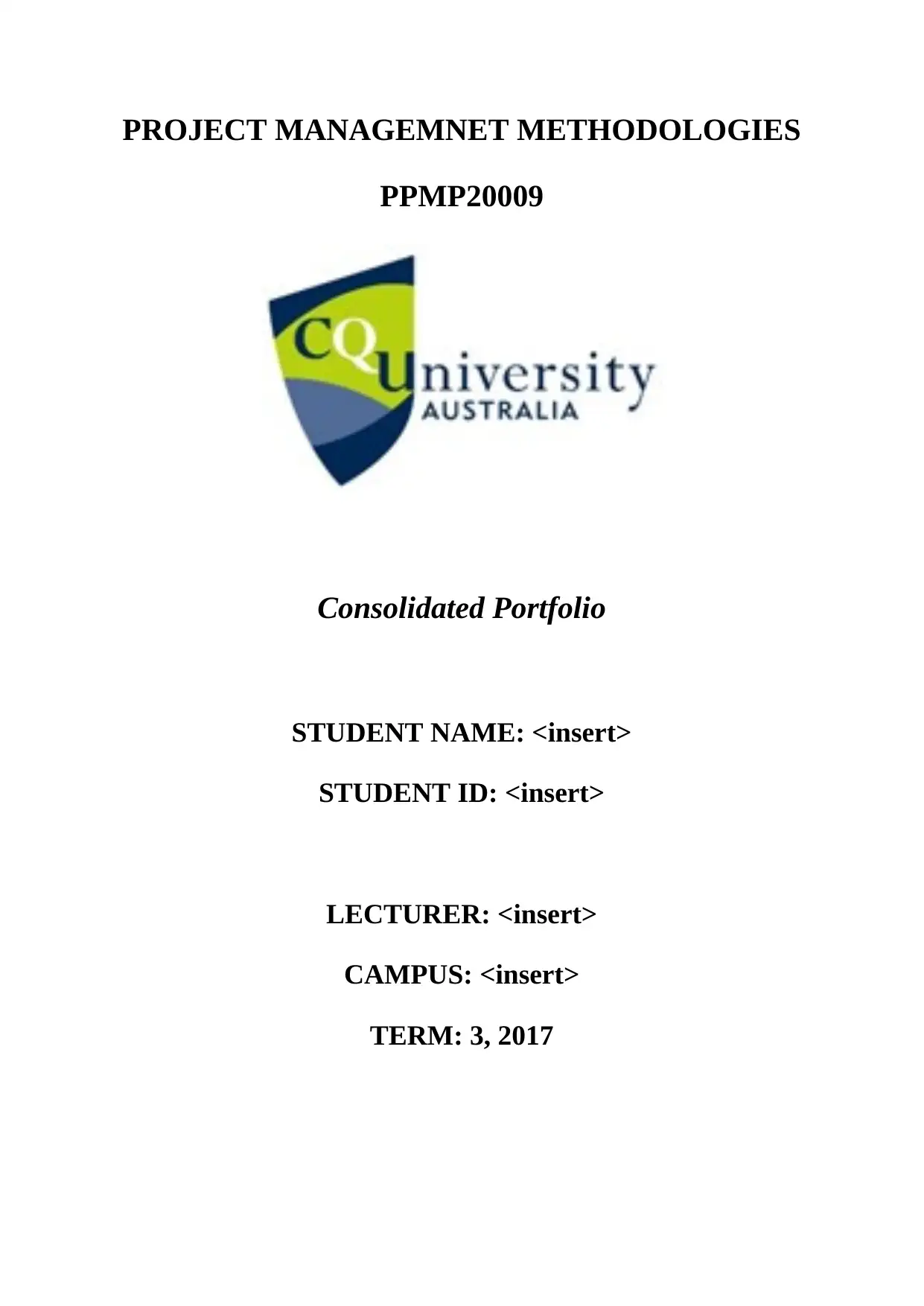
PROJECT MANAGEMNET METHODOLOGIES
PPMP20009
Consolidated Portfolio
STUDENT NAME: <insert>
STUDENT ID: <insert>
LECTURER: <insert>
CAMPUS: <insert>
TERM: 3, 2017
PPMP20009
Consolidated Portfolio
STUDENT NAME: <insert>
STUDENT ID: <insert>
LECTURER: <insert>
CAMPUS: <insert>
TERM: 3, 2017
Paraphrase This Document
Need a fresh take? Get an instant paraphrase of this document with our AI Paraphraser
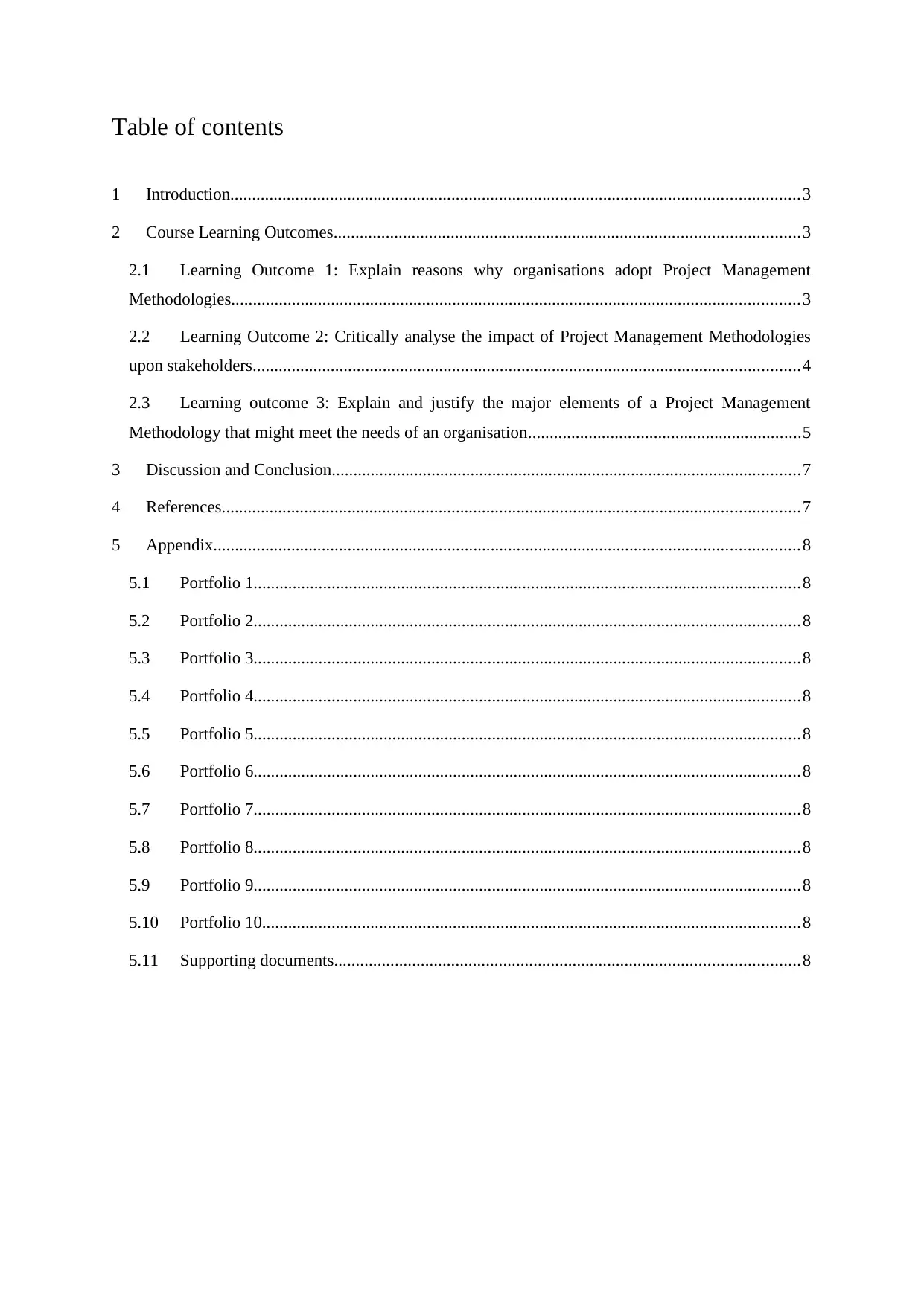
Table of contents
1 Introduction...................................................................................................................................3
2 Course Learning Outcomes...........................................................................................................3
2.1 Learning Outcome 1: Explain reasons why organisations adopt Project Management
Methodologies...................................................................................................................................3
2.2 Learning Outcome 2: Critically analyse the impact of Project Management Methodologies
upon stakeholders..............................................................................................................................4
2.3 Learning outcome 3: Explain and justify the major elements of a Project Management
Methodology that might meet the needs of an organisation...............................................................5
3 Discussion and Conclusion............................................................................................................7
4 References.....................................................................................................................................7
5 Appendix.......................................................................................................................................8
5.1 Portfolio 1..............................................................................................................................8
5.2 Portfolio 2..............................................................................................................................8
5.3 Portfolio 3..............................................................................................................................8
5.4 Portfolio 4..............................................................................................................................8
5.5 Portfolio 5..............................................................................................................................8
5.6 Portfolio 6..............................................................................................................................8
5.7 Portfolio 7..............................................................................................................................8
5.8 Portfolio 8..............................................................................................................................8
5.9 Portfolio 9..............................................................................................................................8
5.10 Portfolio 10............................................................................................................................8
5.11 Supporting documents...........................................................................................................8
1 Introduction...................................................................................................................................3
2 Course Learning Outcomes...........................................................................................................3
2.1 Learning Outcome 1: Explain reasons why organisations adopt Project Management
Methodologies...................................................................................................................................3
2.2 Learning Outcome 2: Critically analyse the impact of Project Management Methodologies
upon stakeholders..............................................................................................................................4
2.3 Learning outcome 3: Explain and justify the major elements of a Project Management
Methodology that might meet the needs of an organisation...............................................................5
3 Discussion and Conclusion............................................................................................................7
4 References.....................................................................................................................................7
5 Appendix.......................................................................................................................................8
5.1 Portfolio 1..............................................................................................................................8
5.2 Portfolio 2..............................................................................................................................8
5.3 Portfolio 3..............................................................................................................................8
5.4 Portfolio 4..............................................................................................................................8
5.5 Portfolio 5..............................................................................................................................8
5.6 Portfolio 6..............................................................................................................................8
5.7 Portfolio 7..............................................................................................................................8
5.8 Portfolio 8..............................................................................................................................8
5.9 Portfolio 9..............................................................................................................................8
5.10 Portfolio 10............................................................................................................................8
5.11 Supporting documents...........................................................................................................8
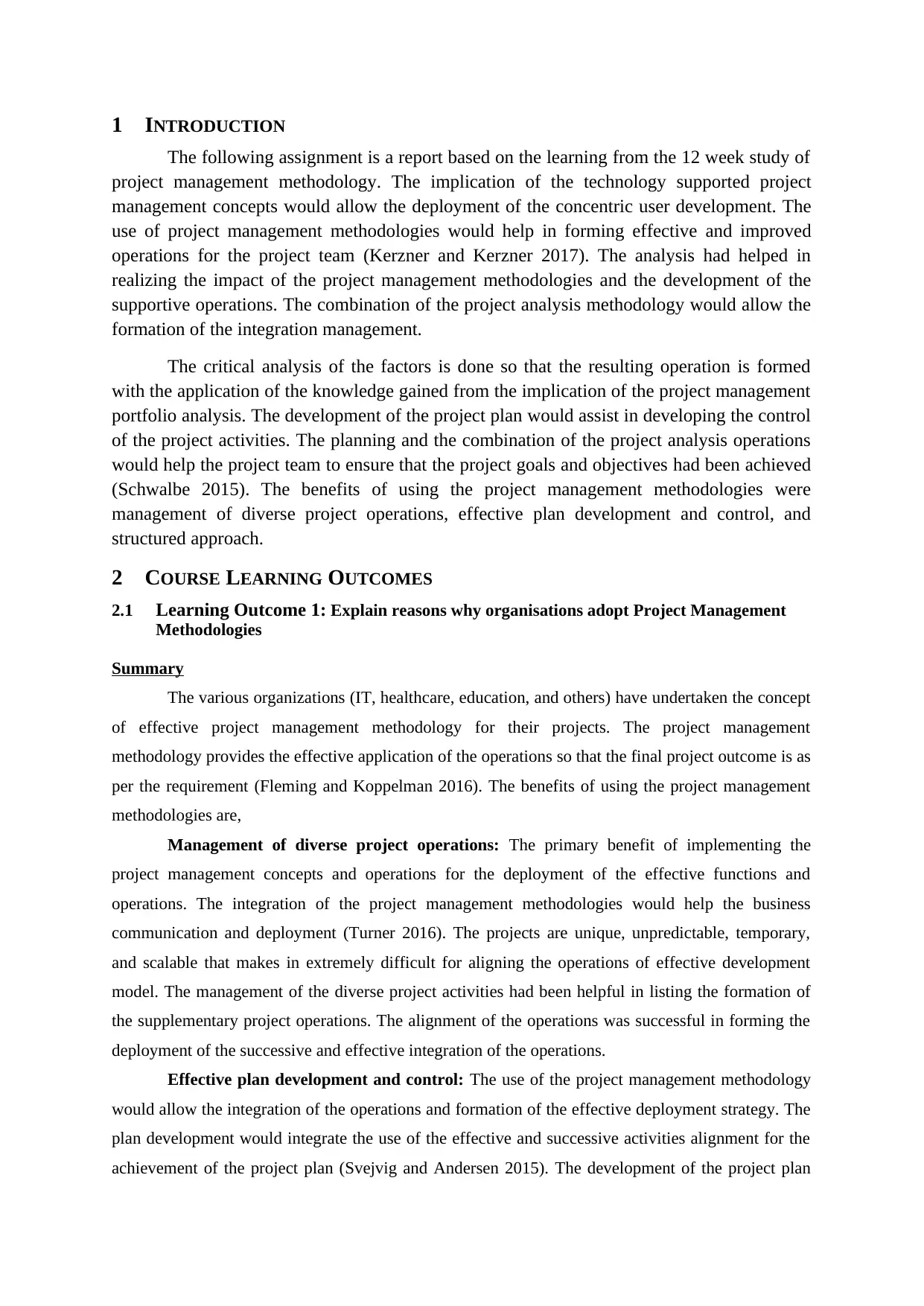
1 INTRODUCTION
The following assignment is a report based on the learning from the 12 week study of
project management methodology. The implication of the technology supported project
management concepts would allow the deployment of the concentric user development. The
use of project management methodologies would help in forming effective and improved
operations for the project team (Kerzner and Kerzner 2017). The analysis had helped in
realizing the impact of the project management methodologies and the development of the
supportive operations. The combination of the project analysis methodology would allow the
formation of the integration management.
The critical analysis of the factors is done so that the resulting operation is formed
with the application of the knowledge gained from the implication of the project management
portfolio analysis. The development of the project plan would assist in developing the control
of the project activities. The planning and the combination of the project analysis operations
would help the project team to ensure that the project goals and objectives had been achieved
(Schwalbe 2015). The benefits of using the project management methodologies were
management of diverse project operations, effective plan development and control, and
structured approach.
2 COURSE LEARNING OUTCOMES
2.1 Learning Outcome 1: Explain reasons why organisations adopt Project Management
Methodologies
Summary
The various organizations (IT, healthcare, education, and others) have undertaken the concept
of effective project management methodology for their projects. The project management
methodology provides the effective application of the operations so that the final project outcome is as
per the requirement (Fleming and Koppelman 2016). The benefits of using the project management
methodologies are,
Management of diverse project operations: The primary benefit of implementing the
project management concepts and operations for the deployment of the effective functions and
operations. The integration of the project management methodologies would help the business
communication and deployment (Turner 2016). The projects are unique, unpredictable, temporary,
and scalable that makes in extremely difficult for aligning the operations of effective development
model. The management of the diverse project activities had been helpful in listing the formation of
the supplementary project operations. The alignment of the operations was successful in forming the
deployment of the successive and effective integration of the operations.
Effective plan development and control: The use of the project management methodology
would allow the integration of the operations and formation of the effective deployment strategy. The
plan development would integrate the use of the effective and successive activities alignment for the
achievement of the project plan (Svejvig and Andersen 2015). The development of the project plan
The following assignment is a report based on the learning from the 12 week study of
project management methodology. The implication of the technology supported project
management concepts would allow the deployment of the concentric user development. The
use of project management methodologies would help in forming effective and improved
operations for the project team (Kerzner and Kerzner 2017). The analysis had helped in
realizing the impact of the project management methodologies and the development of the
supportive operations. The combination of the project analysis methodology would allow the
formation of the integration management.
The critical analysis of the factors is done so that the resulting operation is formed
with the application of the knowledge gained from the implication of the project management
portfolio analysis. The development of the project plan would assist in developing the control
of the project activities. The planning and the combination of the project analysis operations
would help the project team to ensure that the project goals and objectives had been achieved
(Schwalbe 2015). The benefits of using the project management methodologies were
management of diverse project operations, effective plan development and control, and
structured approach.
2 COURSE LEARNING OUTCOMES
2.1 Learning Outcome 1: Explain reasons why organisations adopt Project Management
Methodologies
Summary
The various organizations (IT, healthcare, education, and others) have undertaken the concept
of effective project management methodology for their projects. The project management
methodology provides the effective application of the operations so that the final project outcome is as
per the requirement (Fleming and Koppelman 2016). The benefits of using the project management
methodologies are,
Management of diverse project operations: The primary benefit of implementing the
project management concepts and operations for the deployment of the effective functions and
operations. The integration of the project management methodologies would help the business
communication and deployment (Turner 2016). The projects are unique, unpredictable, temporary,
and scalable that makes in extremely difficult for aligning the operations of effective development
model. The management of the diverse project activities had been helpful in listing the formation of
the supplementary project operations. The alignment of the operations was successful in forming the
deployment of the successive and effective integration of the operations.
Effective plan development and control: The use of the project management methodology
would allow the integration of the operations and formation of the effective deployment strategy. The
plan development would integrate the use of the effective and successive activities alignment for the
achievement of the project plan (Svejvig and Andersen 2015). The development of the project plan
⊘ This is a preview!⊘
Do you want full access?
Subscribe today to unlock all pages.

Trusted by 1+ million students worldwide
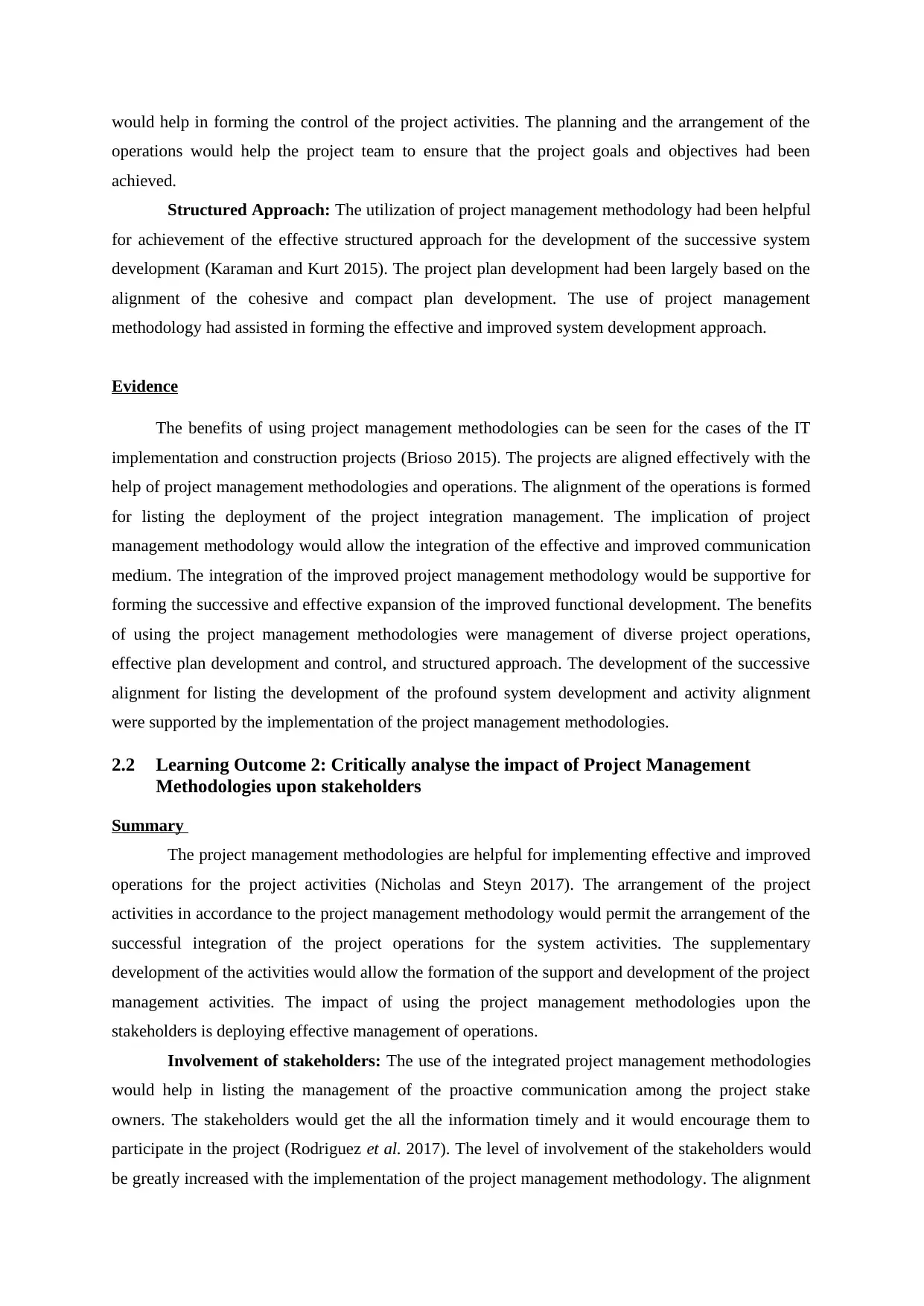
would help in forming the control of the project activities. The planning and the arrangement of the
operations would help the project team to ensure that the project goals and objectives had been
achieved.
Structured Approach: The utilization of project management methodology had been helpful
for achievement of the effective structured approach for the development of the successive system
development (Karaman and Kurt 2015). The project plan development had been largely based on the
alignment of the cohesive and compact plan development. The use of project management
methodology had assisted in forming the effective and improved system development approach.
Evidence
The benefits of using project management methodologies can be seen for the cases of the IT
implementation and construction projects (Brioso 2015). The projects are aligned effectively with the
help of project management methodologies and operations. The alignment of the operations is formed
for listing the deployment of the project integration management. The implication of project
management methodology would allow the integration of the effective and improved communication
medium. The integration of the improved project management methodology would be supportive for
forming the successive and effective expansion of the improved functional development. The benefits
of using the project management methodologies were management of diverse project operations,
effective plan development and control, and structured approach. The development of the successive
alignment for listing the development of the profound system development and activity alignment
were supported by the implementation of the project management methodologies.
2.2 Learning Outcome 2: Critically analyse the impact of Project Management
Methodologies upon stakeholders
Summary
The project management methodologies are helpful for implementing effective and improved
operations for the project activities (Nicholas and Steyn 2017). The arrangement of the project
activities in accordance to the project management methodology would permit the arrangement of the
successful integration of the project operations for the system activities. The supplementary
development of the activities would allow the formation of the support and development of the project
management activities. The impact of using the project management methodologies upon the
stakeholders is deploying effective management of operations.
Involvement of stakeholders: The use of the integrated project management methodologies
would help in listing the management of the proactive communication among the project stake
owners. The stakeholders would get the all the information timely and it would encourage them to
participate in the project (Rodriguez et al. 2017). The level of involvement of the stakeholders would
be greatly increased with the implementation of the project management methodology. The alignment
operations would help the project team to ensure that the project goals and objectives had been
achieved.
Structured Approach: The utilization of project management methodology had been helpful
for achievement of the effective structured approach for the development of the successive system
development (Karaman and Kurt 2015). The project plan development had been largely based on the
alignment of the cohesive and compact plan development. The use of project management
methodology had assisted in forming the effective and improved system development approach.
Evidence
The benefits of using project management methodologies can be seen for the cases of the IT
implementation and construction projects (Brioso 2015). The projects are aligned effectively with the
help of project management methodologies and operations. The alignment of the operations is formed
for listing the deployment of the project integration management. The implication of project
management methodology would allow the integration of the effective and improved communication
medium. The integration of the improved project management methodology would be supportive for
forming the successive and effective expansion of the improved functional development. The benefits
of using the project management methodologies were management of diverse project operations,
effective plan development and control, and structured approach. The development of the successive
alignment for listing the development of the profound system development and activity alignment
were supported by the implementation of the project management methodologies.
2.2 Learning Outcome 2: Critically analyse the impact of Project Management
Methodologies upon stakeholders
Summary
The project management methodologies are helpful for implementing effective and improved
operations for the project activities (Nicholas and Steyn 2017). The arrangement of the project
activities in accordance to the project management methodology would permit the arrangement of the
successful integration of the project operations for the system activities. The supplementary
development of the activities would allow the formation of the support and development of the project
management activities. The impact of using the project management methodologies upon the
stakeholders is deploying effective management of operations.
Involvement of stakeholders: The use of the integrated project management methodologies
would help in listing the management of the proactive communication among the project stake
owners. The stakeholders would get the all the information timely and it would encourage them to
participate in the project (Rodriguez et al. 2017). The level of involvement of the stakeholders would
be greatly increased with the implementation of the project management methodology. The alignment
Paraphrase This Document
Need a fresh take? Get an instant paraphrase of this document with our AI Paraphraser
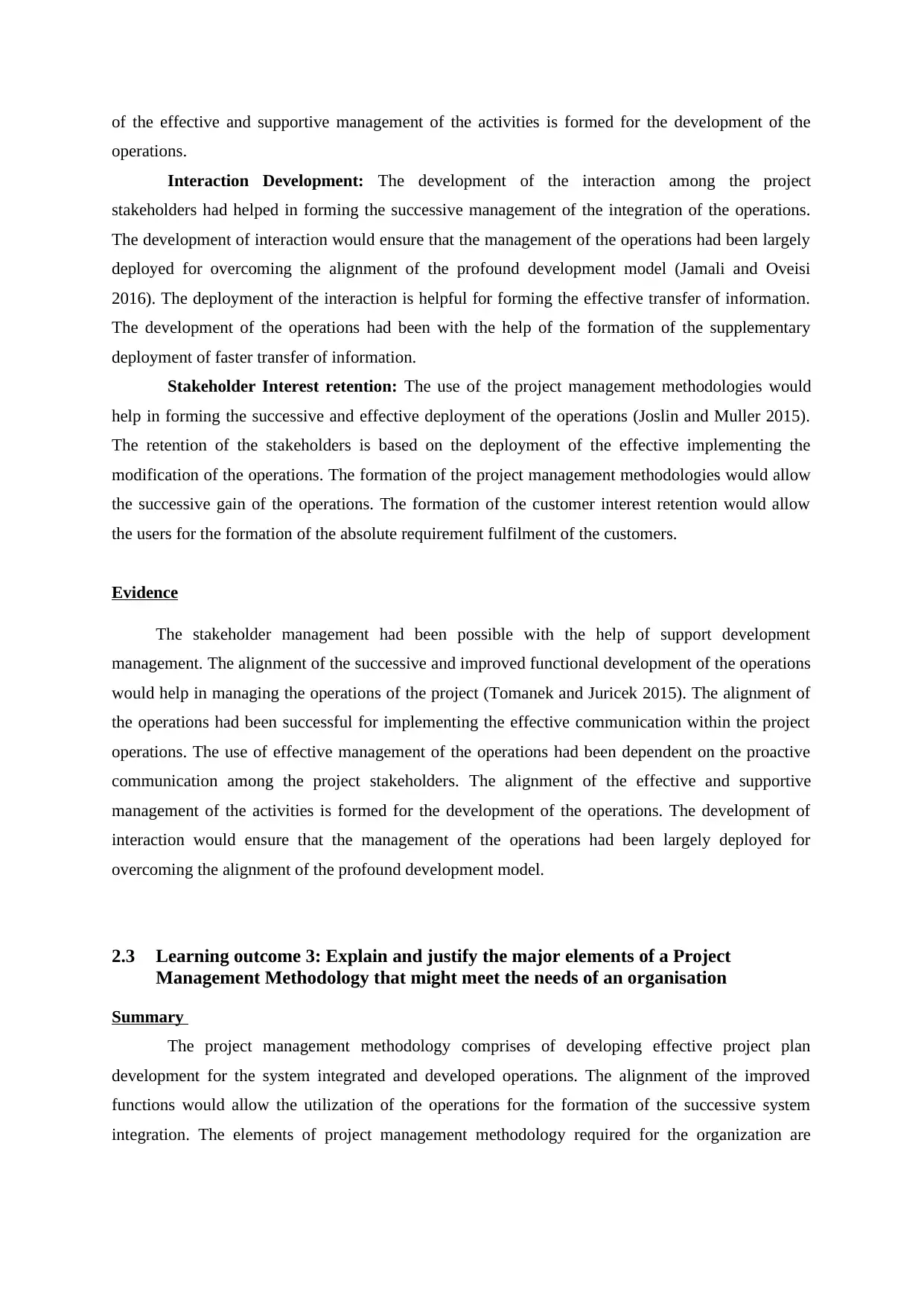
of the effective and supportive management of the activities is formed for the development of the
operations.
Interaction Development: The development of the interaction among the project
stakeholders had helped in forming the successive management of the integration of the operations.
The development of interaction would ensure that the management of the operations had been largely
deployed for overcoming the alignment of the profound development model (Jamali and Oveisi
2016). The deployment of the interaction is helpful for forming the effective transfer of information.
The development of the operations had been with the help of the formation of the supplementary
deployment of faster transfer of information.
Stakeholder Interest retention: The use of the project management methodologies would
help in forming the successive and effective deployment of the operations (Joslin and Muller 2015).
The retention of the stakeholders is based on the deployment of the effective implementing the
modification of the operations. The formation of the project management methodologies would allow
the successive gain of the operations. The formation of the customer interest retention would allow
the users for the formation of the absolute requirement fulfilment of the customers.
Evidence
The stakeholder management had been possible with the help of support development
management. The alignment of the successive and improved functional development of the operations
would help in managing the operations of the project (Tomanek and Juricek 2015). The alignment of
the operations had been successful for implementing the effective communication within the project
operations. The use of effective management of the operations had been dependent on the proactive
communication among the project stakeholders. The alignment of the effective and supportive
management of the activities is formed for the development of the operations. The development of
interaction would ensure that the management of the operations had been largely deployed for
overcoming the alignment of the profound development model.
2.3 Learning outcome 3: Explain and justify the major elements of a Project
Management Methodology that might meet the needs of an organisation
Summary
The project management methodology comprises of developing effective project plan
development for the system integrated and developed operations. The alignment of the improved
functions would allow the utilization of the operations for the formation of the successive system
integration. The elements of project management methodology required for the organization are
operations.
Interaction Development: The development of the interaction among the project
stakeholders had helped in forming the successive management of the integration of the operations.
The development of interaction would ensure that the management of the operations had been largely
deployed for overcoming the alignment of the profound development model (Jamali and Oveisi
2016). The deployment of the interaction is helpful for forming the effective transfer of information.
The development of the operations had been with the help of the formation of the supplementary
deployment of faster transfer of information.
Stakeholder Interest retention: The use of the project management methodologies would
help in forming the successive and effective deployment of the operations (Joslin and Muller 2015).
The retention of the stakeholders is based on the deployment of the effective implementing the
modification of the operations. The formation of the project management methodologies would allow
the successive gain of the operations. The formation of the customer interest retention would allow
the users for the formation of the absolute requirement fulfilment of the customers.
Evidence
The stakeholder management had been possible with the help of support development
management. The alignment of the successive and improved functional development of the operations
would help in managing the operations of the project (Tomanek and Juricek 2015). The alignment of
the operations had been successful for implementing the effective communication within the project
operations. The use of effective management of the operations had been dependent on the proactive
communication among the project stakeholders. The alignment of the effective and supportive
management of the activities is formed for the development of the operations. The development of
interaction would ensure that the management of the operations had been largely deployed for
overcoming the alignment of the profound development model.
2.3 Learning outcome 3: Explain and justify the major elements of a Project
Management Methodology that might meet the needs of an organisation
Summary
The project management methodology comprises of developing effective project plan
development for the system integrated and developed operations. The alignment of the improved
functions would allow the utilization of the operations for the formation of the successive system
integration. The elements of project management methodology required for the organization are
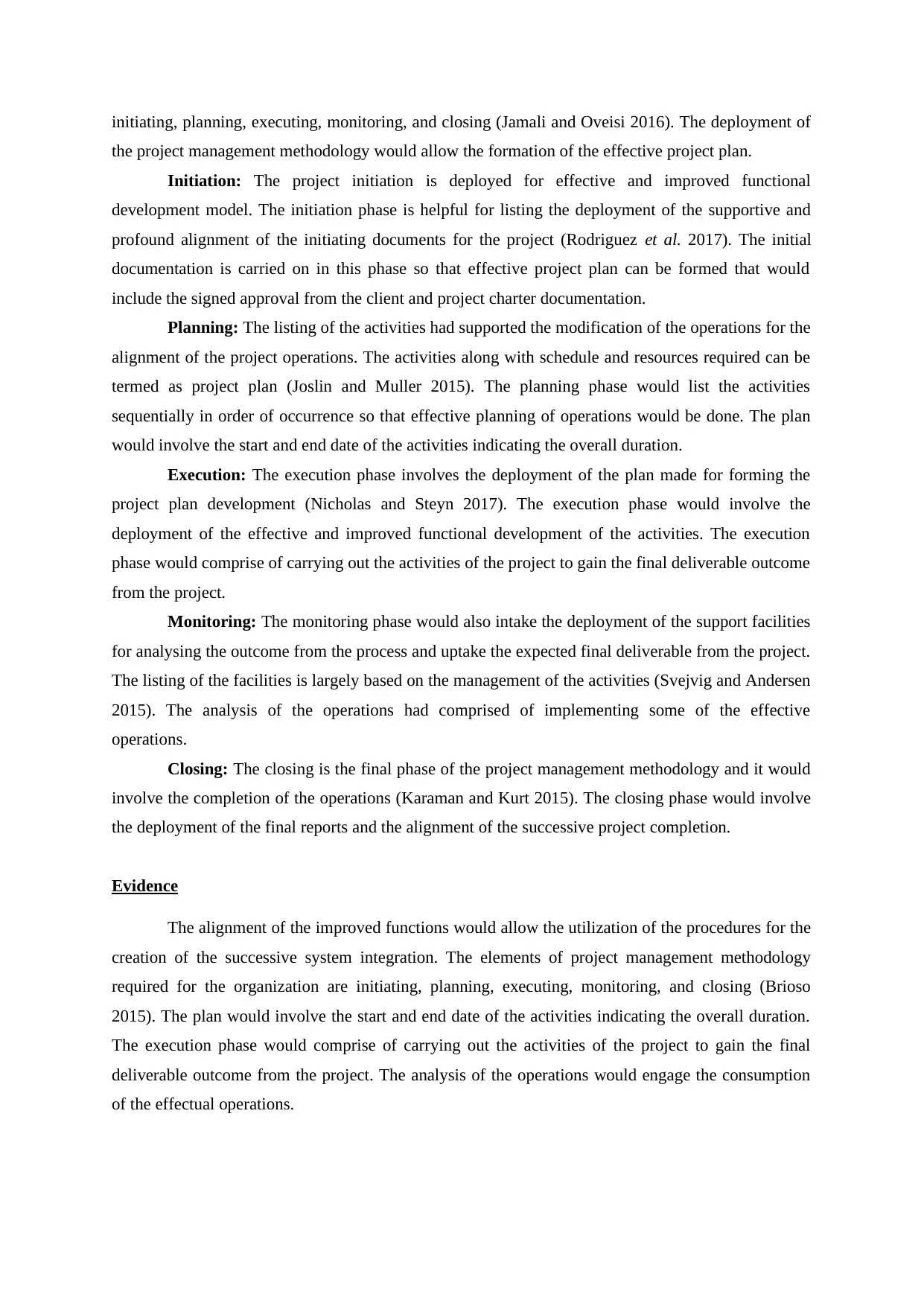
initiating, planning, executing, monitoring, and closing (Jamali and Oveisi 2016). The deployment of
the project management methodology would allow the formation of the effective project plan.
Initiation: The project initiation is deployed for effective and improved functional
development model. The initiation phase is helpful for listing the deployment of the supportive and
profound alignment of the initiating documents for the project (Rodriguez et al. 2017). The initial
documentation is carried on in this phase so that effective project plan can be formed that would
include the signed approval from the client and project charter documentation.
Planning: The listing of the activities had supported the modification of the operations for the
alignment of the project operations. The activities along with schedule and resources required can be
termed as project plan (Joslin and Muller 2015). The planning phase would list the activities
sequentially in order of occurrence so that effective planning of operations would be done. The plan
would involve the start and end date of the activities indicating the overall duration.
Execution: The execution phase involves the deployment of the plan made for forming the
project plan development (Nicholas and Steyn 2017). The execution phase would involve the
deployment of the effective and improved functional development of the activities. The execution
phase would comprise of carrying out the activities of the project to gain the final deliverable outcome
from the project.
Monitoring: The monitoring phase would also intake the deployment of the support facilities
for analysing the outcome from the process and uptake the expected final deliverable from the project.
The listing of the facilities is largely based on the management of the activities (Svejvig and Andersen
2015). The analysis of the operations had comprised of implementing some of the effective
operations.
Closing: The closing is the final phase of the project management methodology and it would
involve the completion of the operations (Karaman and Kurt 2015). The closing phase would involve
the deployment of the final reports and the alignment of the successive project completion.
Evidence
The alignment of the improved functions would allow the utilization of the procedures for the
creation of the successive system integration. The elements of project management methodology
required for the organization are initiating, planning, executing, monitoring, and closing (Brioso
2015). The plan would involve the start and end date of the activities indicating the overall duration.
The execution phase would comprise of carrying out the activities of the project to gain the final
deliverable outcome from the project. The analysis of the operations would engage the consumption
of the effectual operations.
the project management methodology would allow the formation of the effective project plan.
Initiation: The project initiation is deployed for effective and improved functional
development model. The initiation phase is helpful for listing the deployment of the supportive and
profound alignment of the initiating documents for the project (Rodriguez et al. 2017). The initial
documentation is carried on in this phase so that effective project plan can be formed that would
include the signed approval from the client and project charter documentation.
Planning: The listing of the activities had supported the modification of the operations for the
alignment of the project operations. The activities along with schedule and resources required can be
termed as project plan (Joslin and Muller 2015). The planning phase would list the activities
sequentially in order of occurrence so that effective planning of operations would be done. The plan
would involve the start and end date of the activities indicating the overall duration.
Execution: The execution phase involves the deployment of the plan made for forming the
project plan development (Nicholas and Steyn 2017). The execution phase would involve the
deployment of the effective and improved functional development of the activities. The execution
phase would comprise of carrying out the activities of the project to gain the final deliverable outcome
from the project.
Monitoring: The monitoring phase would also intake the deployment of the support facilities
for analysing the outcome from the process and uptake the expected final deliverable from the project.
The listing of the facilities is largely based on the management of the activities (Svejvig and Andersen
2015). The analysis of the operations had comprised of implementing some of the effective
operations.
Closing: The closing is the final phase of the project management methodology and it would
involve the completion of the operations (Karaman and Kurt 2015). The closing phase would involve
the deployment of the final reports and the alignment of the successive project completion.
Evidence
The alignment of the improved functions would allow the utilization of the procedures for the
creation of the successive system integration. The elements of project management methodology
required for the organization are initiating, planning, executing, monitoring, and closing (Brioso
2015). The plan would involve the start and end date of the activities indicating the overall duration.
The execution phase would comprise of carrying out the activities of the project to gain the final
deliverable outcome from the project. The analysis of the operations would engage the consumption
of the effectual operations.
⊘ This is a preview!⊘
Do you want full access?
Subscribe today to unlock all pages.

Trusted by 1+ million students worldwide
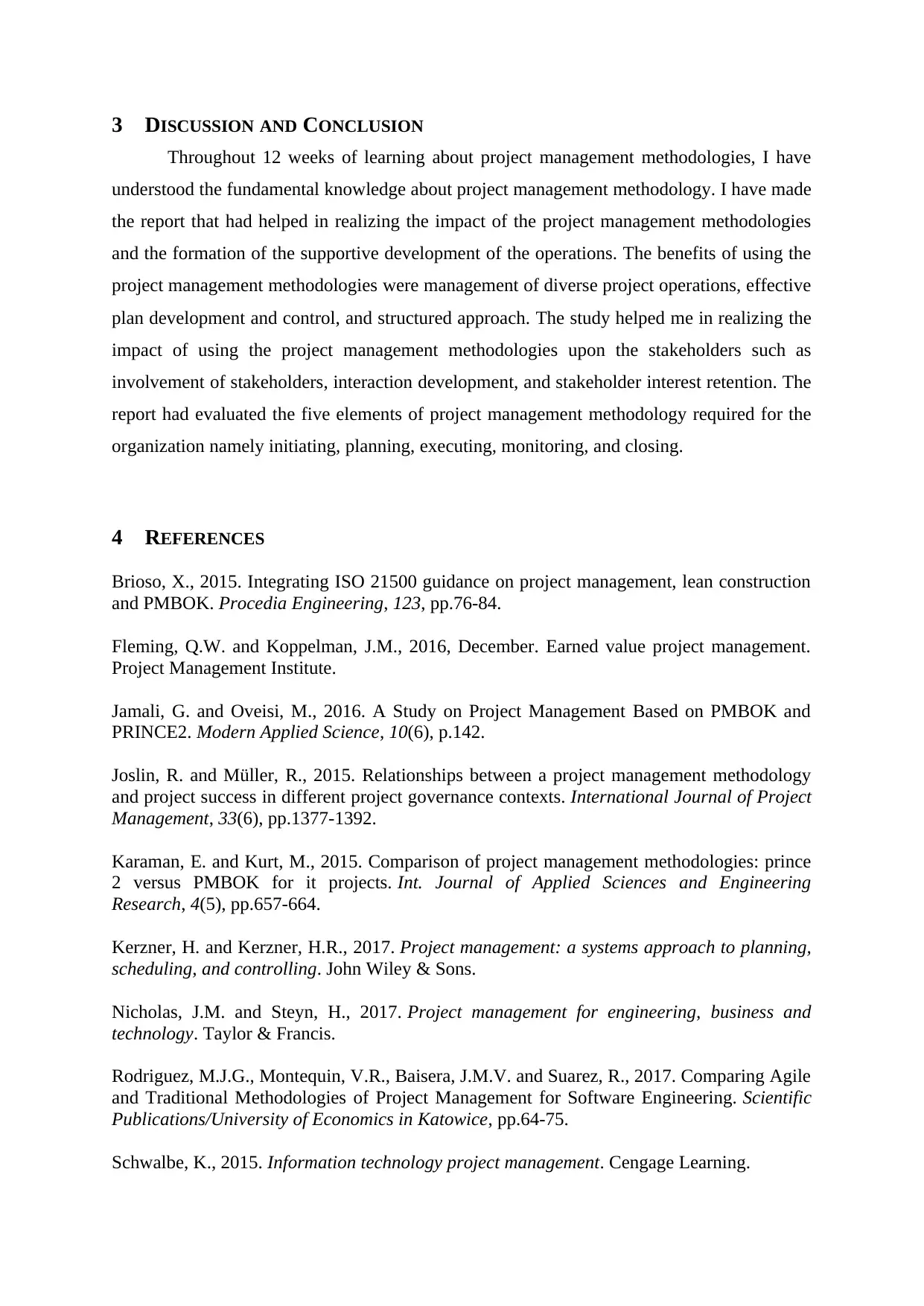
3 DISCUSSION AND CONCLUSION
Throughout 12 weeks of learning about project management methodologies, I have
understood the fundamental knowledge about project management methodology. I have made
the report that had helped in realizing the impact of the project management methodologies
and the formation of the supportive development of the operations. The benefits of using the
project management methodologies were management of diverse project operations, effective
plan development and control, and structured approach. The study helped me in realizing the
impact of using the project management methodologies upon the stakeholders such as
involvement of stakeholders, interaction development, and stakeholder interest retention. The
report had evaluated the five elements of project management methodology required for the
organization namely initiating, planning, executing, monitoring, and closing.
4 REFERENCES
Brioso, X., 2015. Integrating ISO 21500 guidance on project management, lean construction
and PMBOK. Procedia Engineering, 123, pp.76-84.
Fleming, Q.W. and Koppelman, J.M., 2016, December. Earned value project management.
Project Management Institute.
Jamali, G. and Oveisi, M., 2016. A Study on Project Management Based on PMBOK and
PRINCE2. Modern Applied Science, 10(6), p.142.
Joslin, R. and Müller, R., 2015. Relationships between a project management methodology
and project success in different project governance contexts. International Journal of Project
Management, 33(6), pp.1377-1392.
Karaman, E. and Kurt, M., 2015. Comparison of project management methodologies: prince
2 versus PMBOK for it projects. Int. Journal of Applied Sciences and Engineering
Research, 4(5), pp.657-664.
Kerzner, H. and Kerzner, H.R., 2017. Project management: a systems approach to planning,
scheduling, and controlling. John Wiley & Sons.
Nicholas, J.M. and Steyn, H., 2017. Project management for engineering, business and
technology. Taylor & Francis.
Rodriguez, M.J.G., Montequin, V.R., Baisera, J.M.V. and Suarez, R., 2017. Comparing Agile
and Traditional Methodologies of Project Management for Software Engineering. Scientific
Publications/University of Economics in Katowice, pp.64-75.
Schwalbe, K., 2015. Information technology project management. Cengage Learning.
Throughout 12 weeks of learning about project management methodologies, I have
understood the fundamental knowledge about project management methodology. I have made
the report that had helped in realizing the impact of the project management methodologies
and the formation of the supportive development of the operations. The benefits of using the
project management methodologies were management of diverse project operations, effective
plan development and control, and structured approach. The study helped me in realizing the
impact of using the project management methodologies upon the stakeholders such as
involvement of stakeholders, interaction development, and stakeholder interest retention. The
report had evaluated the five elements of project management methodology required for the
organization namely initiating, planning, executing, monitoring, and closing.
4 REFERENCES
Brioso, X., 2015. Integrating ISO 21500 guidance on project management, lean construction
and PMBOK. Procedia Engineering, 123, pp.76-84.
Fleming, Q.W. and Koppelman, J.M., 2016, December. Earned value project management.
Project Management Institute.
Jamali, G. and Oveisi, M., 2016. A Study on Project Management Based on PMBOK and
PRINCE2. Modern Applied Science, 10(6), p.142.
Joslin, R. and Müller, R., 2015. Relationships between a project management methodology
and project success in different project governance contexts. International Journal of Project
Management, 33(6), pp.1377-1392.
Karaman, E. and Kurt, M., 2015. Comparison of project management methodologies: prince
2 versus PMBOK for it projects. Int. Journal of Applied Sciences and Engineering
Research, 4(5), pp.657-664.
Kerzner, H. and Kerzner, H.R., 2017. Project management: a systems approach to planning,
scheduling, and controlling. John Wiley & Sons.
Nicholas, J.M. and Steyn, H., 2017. Project management for engineering, business and
technology. Taylor & Francis.
Rodriguez, M.J.G., Montequin, V.R., Baisera, J.M.V. and Suarez, R., 2017. Comparing Agile
and Traditional Methodologies of Project Management for Software Engineering. Scientific
Publications/University of Economics in Katowice, pp.64-75.
Schwalbe, K., 2015. Information technology project management. Cengage Learning.
Paraphrase This Document
Need a fresh take? Get an instant paraphrase of this document with our AI Paraphraser
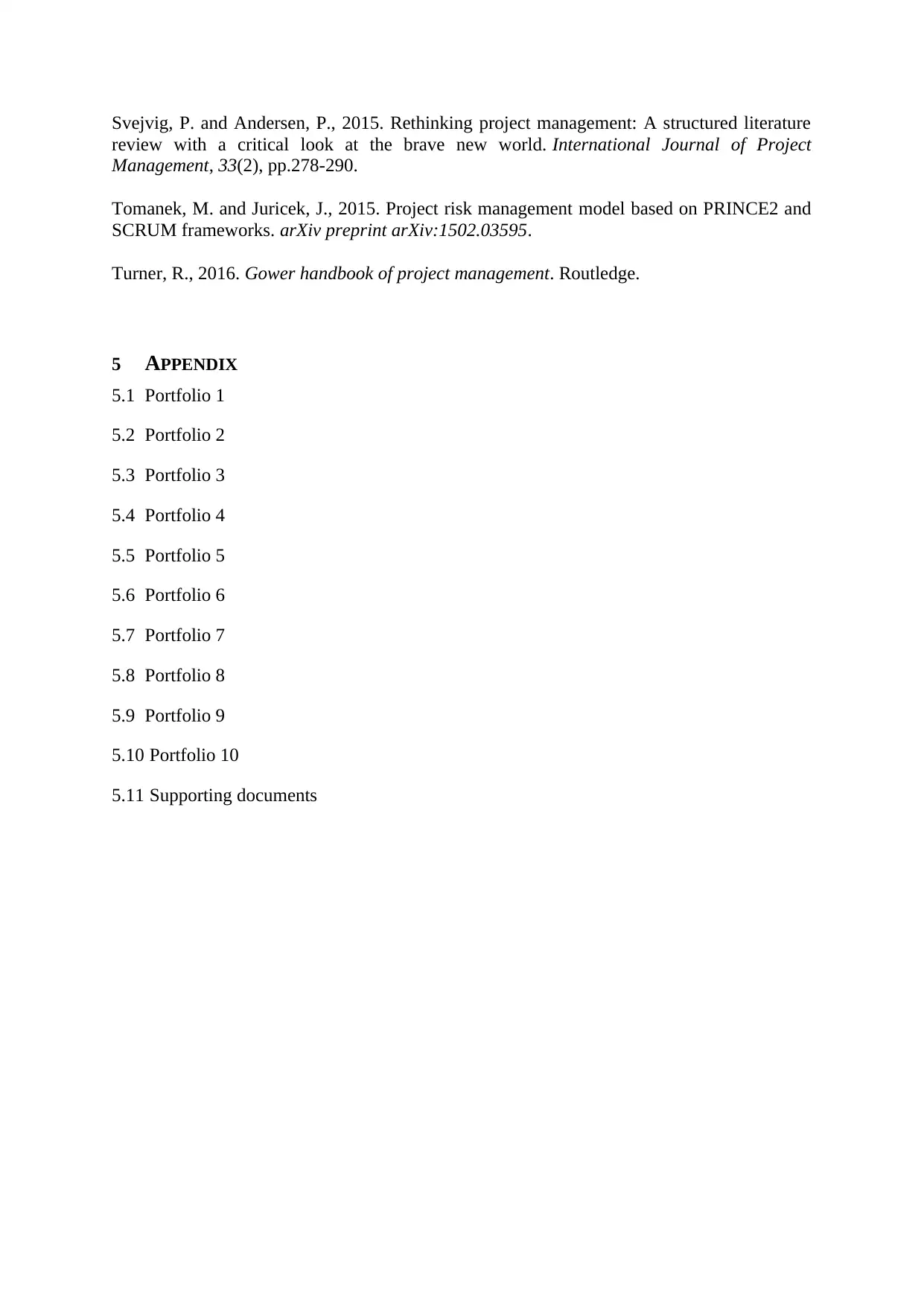
Svejvig, P. and Andersen, P., 2015. Rethinking project management: A structured literature
review with a critical look at the brave new world. International Journal of Project
Management, 33(2), pp.278-290.
Tomanek, M. and Juricek, J., 2015. Project risk management model based on PRINCE2 and
SCRUM frameworks. arXiv preprint arXiv:1502.03595.
Turner, R., 2016. Gower handbook of project management. Routledge.
5 APPENDIX
5.1 Portfolio 1
5.2 Portfolio 2
5.3 Portfolio 3
5.4 Portfolio 4
5.5 Portfolio 5
5.6 Portfolio 6
5.7 Portfolio 7
5.8 Portfolio 8
5.9 Portfolio 9
5.10 Portfolio 10
5.11 Supporting documents
review with a critical look at the brave new world. International Journal of Project
Management, 33(2), pp.278-290.
Tomanek, M. and Juricek, J., 2015. Project risk management model based on PRINCE2 and
SCRUM frameworks. arXiv preprint arXiv:1502.03595.
Turner, R., 2016. Gower handbook of project management. Routledge.
5 APPENDIX
5.1 Portfolio 1
5.2 Portfolio 2
5.3 Portfolio 3
5.4 Portfolio 4
5.5 Portfolio 5
5.6 Portfolio 6
5.7 Portfolio 7
5.8 Portfolio 8
5.9 Portfolio 9
5.10 Portfolio 10
5.11 Supporting documents

⊘ This is a preview!⊘
Do you want full access?
Subscribe today to unlock all pages.

Trusted by 1+ million students worldwide
1 out of 9
Related Documents
Your All-in-One AI-Powered Toolkit for Academic Success.
+13062052269
info@desklib.com
Available 24*7 on WhatsApp / Email
![[object Object]](/_next/static/media/star-bottom.7253800d.svg)
Unlock your academic potential
Copyright © 2020–2025 A2Z Services. All Rights Reserved. Developed and managed by ZUCOL.




